stop start MITSUBISHI MIRAGE G4 2020 Owner's Manual (in English)
[x] Cancel search | Manufacturer: MITSUBISHI, Model Year: 2020, Model line: MIRAGE G4, Model: MITSUBISHI MIRAGE G4 2020Pages: 253, PDF Size: 36.39 MB
Page 14 of 253

If this warning light comes on or
flashes while you’re driving...
Quick index 2-3
2
Anti-lock braking system warning
light
When this light comes on,
the anti-lock braking system
is not functioning and only
the ordinary braking system is functioning. Park your vehicle in a safe
place and stop the engine.
Test the system as described on page 5-50. If the light does not go out after
the test, or if it comes on
again, we recommend that
you have the system checked at an authorized
Mitsubishi Motors dealer or a repair
facility of your choice
as soon as possible.
P. 5-50
SRS warning light
Immediately have the airbag and the pre-te
nsioner seat belt sy
stem checked at an
authorized Mitsubishi Motors dealer.
P. 4-28
Selector lever position indicator in the instrument cluste
r flashes slowly
(every 2 seconds)
Have your continuously variable transmis
sion (CVT) checked at an authorized
Mitsubishi Motors dealer or a repair
facility of your ch
oice immediately.
P. 5-45
and
ASC indicator and ASC OFF indicator
Park your vehicle in a safe
place and stop the engine.
Restart the engine and check
whether the indicator goes out.
If the indicator does not go out, or if it
comes on again, have
your vehicle inspected
by an authorized Mitsubishi Motors dealer or
a repair facility of your choice as soon
as possible. When this indicator comes on, the activ
e stability control is not functioning.
P. 5-54
Wa rn in g l ig h t s
Do this
Ref. Page
BK0284300US.book 3 ページ 2019年5月23日 木曜日 午後12時22分
Page 15 of 253

If this warning light comes on or flashes while you’re driving... 2-4 Quick index
2
ASC indicator
Park your vehicle in a safe
place and stop the engine.
Restart the engine and check wh
ether the indicator goes out.
If the indicator does not go out, or if it co
mes on again, have your vehicle inspected
by an authorized Mitsubishi Motors dealer
or a repair facility of
your choice as soon
as possible. When this indicator comes on, the hi
ll start assist
is not functioning.
Start off carefully on a steep uphill slope.
P. 5-49
Tire pressure monito
ring system warn-
ing light
If the warning light comes
on, you should stop and adju
st the tires to the proper
inflation pressure as
soon as possible.
(See “Tire inflation pressures” on page 9-16.) Once adjustments have been made, the wa
rning light will go off after a few minutes
of driving. If the warning light blinks
for approximately 1 minute
and then remains continu-
ously illuminated, the system is not operating properly. If the system returns to nor-mal, the warning light will go off. If th
e warning light does not go off, have the
vehicle inspected at an author
ized Mitsubishi Motors dealer.
P. 5-58
Warning lights
Do this
Ref. Page
BK0284300US.book 4 ページ 2019年5月23日 木曜日 午後12時22分
Page 38 of 253
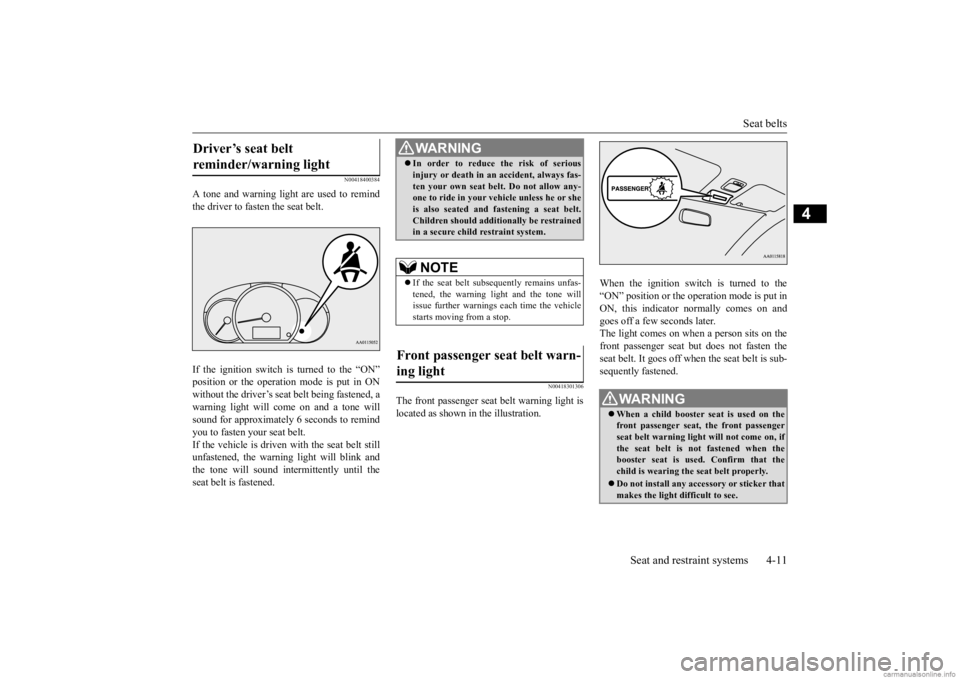
Seat belts
Seat and restraint systems 4-11
4
N00418400384
A tone and warning light are used to remind the driver to fasten the seat belt. If the ignition switch is turned to the “ON” position or the operation mode is put in ON without the driver’s seat belt being fastened, a warning light will come on and a tone willsound for approximately 6 seconds to remind you to fasten your seat belt. If the vehicle is driven with the seat belt stillunfastened, the warning light will blink and the tone will sound inte
rmittently until the
seat belt is fastened.
N00418301306
The front passenger seat
belt warning light is
located as shown in
the illustration.
When the ignition switch is turned to the “ON” position or the operation mode is put inON, this indicator
normally comes on and
goes off a few seconds later. The light comes on when a person sits on thefront passenger seat bu
t does not fasten the
seat belt. It goes off when the seat belt is sub- sequently fastened.
Driver’s seat belt reminder/warning light
WA R N I N G In order to reduce the risk of serious injury or death in an
accident, always fas-
ten your own seat belt
. Do not allow any-
one to ride in your ve
hicle unless he or she
is also seated and fastening a seat belt. Children should additi
onally be restrained
in a secure child restraint system.NOTE
If the seat belt subse
quently remains unfas-
tened, the warning li
ght and the tone will
issue further warnings
each time the vehicle
starts moving from a stop.
Front passenger seat belt warn- ing light
WA R N I N G When a child booster se
at is used on the
front passenger seat, the front passenger seat belt warning ligh
t will not come on, if
the seat belt is not fastened when the booster seat is used
. Confirm that the
child is wearing the
seat belt properly.
Do not install any acce
ssory or sticker that
makes the light difficult to see.
BK0284300US.book 11 ページ 2019年5月23日 木曜日 午後12時22分
Page 81 of 253

Free-hand Advanced
Security Transmitter (F.A.S
.T.-key) (if so equipped)
5-16 Features and controls
5
N00559901184
When the operation mode is in OFF, the F.A.S.T.-key is left in the passenger compart-ment, all the doors are closed, and someone tries to lock the vehicle by pressing the driver’s door lock/unlock switch, the warninglight blinks and the bu
zzer sounds for about 3
seconds as a warning,
and the doors cannot be
locked.
N00560001185
When the operation mode is in OFF, andsomeone tries to lock the vehicle by pressingthe driver’s door lock/unlock switch while one of the doors is not fully closed, the warn- ing light blinks and
the buzzer sounds for
about 3 seconds as a warning, and the doors cannot be locked.
N00560101199
When the operation m
ode is in any mode
other than OFF, and someone tries to lock the vehicle by pressing the driver’s doorlock/unlock switch, th
e warning light blinks
and the buzzer sounds fo
r about 3 seconds as
a warning, and the doors cannot be locked.
N00514601357
The operation mode ca
n be in any mode
to start the engine. The starter motor will be turning for up to approximately 15 seconds if the engine switch is released at once. Pressing the engine switch again while the starter motor is still turning will stop the starter motor. The starter motor will be turningfor up to approximately 30 seconds while the engine swit
ch is pressed.
If the engine does not start, wait for awhile and then attempt to start the engine again. Trying repeatedly with the starter motor still turning will damage the startermechanism. If the engine will not start because the bat- tery is weak or discharged, refer to“Jump-starting the engine” on page 8-2 for instructions. A longer warm up period will only con- sume extra fuel. The engine is warmed up enough for driv- ing when the low coolant temperatureindicator goes out. Refer to “Low coolant temperature indi- cator” on page 5-75.
NOTE
The F.A.S.T.-key take
-out monitoring system
does not function if the F.A.S.T.-key isremoved through a window without openinga door. This setting can be changed. See an authorized Mi
tsubishi Motors dealer
for details. The warning may display even if the F.A.S.T.-key is in the operating range for starting the engine a
nd changing the opera-
tion mode. The surrounding environment orelectromagnetic waves
may make it impossi-
ble to verify the ID codes of the F.A.S.T.-key and vehicle.
Key lock-in prevention system
Door ajar prevention system
Operation mode OFF reminder system
Starting and stopping the engine
Tips for starting
BK0284300US.book 16 ページ 2019年5月23日 木曜日 午後12時22分
Page 83 of 253
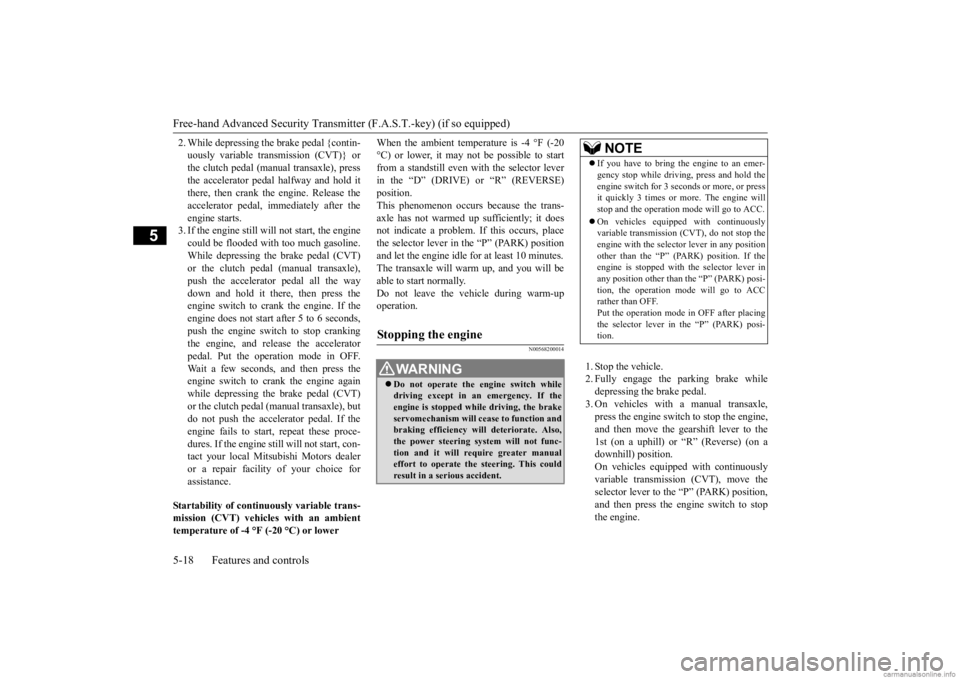
Free-hand Advanced
Security Transmitter (F.A.S
.T.-key) (if so equipped)
5-18 Features and controls
5
2. While depressing the brake pedal {contin- uously variable transmission (CVT)} orthe clutch pedal (manual transaxle), press the accelerator peda
l halfway and hold it
there, then crank th
e engine. Release the
accelerator pedal, immediately after the engine starts. 3. If the engine still will
not start, the engine
could be flooded with too much gasoline. While depressing the brake pedal (CVT) or the clutch pedal (manual transaxle), push the accelerator pedal all the way down and hold it there, then press theengine switch to crank the engine. If the engine does not start
after 5 to 6 seconds,
push the engine switch to stop crankingthe engine, and release the accelerator pedal. Put the opera
tion mode in OFF.
Wait a few seconds, and then press theengine switch to crank the engine again while depressing the brake pedal (CVT) or the clutch pedal (manual transaxle), butdo not push the accelerator pedal. If the engine fails to start, repeat these proce- dures. If the engine stil
l will not start, con-
tact your local Mitsubishi Motors dealer or a repair facility of your choice for assistance.
Startability of continuo
usly variable trans-
mission (CVT) vehicles with an ambient temperature of -4 °F (-20 °C) or lower
When the ambient temperature is -4 °F (-20 °C) or lower, it may not be possible to startfrom a standstill even wi
th the selector lever
in the “D” (DRIVE) or “R” (REVERSE) position.This phenomenon occurs because the trans- axle has not warmed up sufficiently; it does not indicate a problem.
If this occurs, place
the selector lever in the “P” (PARK) position and let the engine idle
for at least 10 minutes.
The transaxle will wa
rm up, and you will be
able to start normally. Do not leave the vehicle during warm-upoperation.
N00568200014
1. Stop the vehicle.2. Fully engage the parking brake while depressing the brake pedal. 3. On vehicles with
a manual transaxle,
press the engine switch to stop the engine, and then move the gearshift lever to the 1st (on a uphill) or “R” (Reverse) (on adownhill) position. On vehicles equippe
d with continuously
variable transmission (CVT), move theselector lever to the “P” (PARK) position, and then press the e
ngine switch to stop
the engine.
Stopping the engine
WA R N I N G Do not operate the en
gine switch while
driving except in an emergency. If the engine is stopped while driving, the brakeservomechanism will ce
ase to function and
braking efficiency will deteriorate. Also, the power steering system will not func-tion and it will require greater manual effort to operate the steering. This could result in a serious accident.
NOTE
If you have to bring the engine to an emer- gency stop while drivi
ng, press and hold the
engine switch for 3 seconds or more, or pressit quickly 3 times or
more. The engine will
stop and the operation mode will go to ACC. On vehicles equipped with continuously variable transmission (CVT), do not stop the engine with the selector
lever in any position
other than the “P” (PARK) position. If the engine is stopped with
the selector lever in
any position other than the “P” (PARK) posi-tion, the operation mode will go to ACC rather than OFF. Put the operation mode
in OFF after placing
the selector lever in the “P” (PARK) posi- tion.
BK0284300US.book 18 ページ 2019年5月23日 木曜日 午後12時22分
Page 103 of 253
![MITSUBISHI MIRAGE G4 2020 Owners Manual (in English) Starting the engine 5-38 Features and controls
5
N00512601861
[For vehicles equipped with the Free-hand Advanced Security Transmitter (F.A.S.T.- key)]
For information on
operation for vehicles
equ MITSUBISHI MIRAGE G4 2020 Owners Manual (in English) Starting the engine 5-38 Features and controls
5
N00512601861
[For vehicles equipped with the Free-hand Advanced Security Transmitter (F.A.S.T.- key)]
For information on
operation for vehicles
equ](/img/19/34857/w960_34857-102.png)
Starting the engine 5-38 Features and controls
5
N00512601861
[For vehicles equipped with the Free-hand Advanced Security Transmitter (F.A.S.T.- key)]
For information on
operation for vehicles
equipped with the Free-hand Advanced Secu-rity Transmitter (F.A
.S.T.-key), refer to
“Free-hand Advanced
Security Transmitter
(F.A.S.T.-key): Starting and stopping theengine” on page 5-16. [Except for vehicles equipped with the Free-hand Advanced Se
curity Transmit-
ter (F.A.S.T.-key)] Do not operate the starter motor continu- ously for longer than 15 seconds as thiscould run the battery
down or damage the
starter motor. If the engine does not start, turn the ignition switch back to the “OFF”position, wait a few se
conds, and then try
again. Trying repeatedly with the engine or starter motor still turning will damagethe starter mechanism. If the engine will not
start because the bat-
tery is weak or discharged, refer to“Jump-starting the engine” (on page 8-2) for instructions. A longer warm up period will only con- sume extra fuel. The engine is warmed up enough for driving when the low coolant temperature indi
cator goes out.
Refer to “Low coolant temperature indi- cator” on page 5-75.
This model is equipped with an electronically controlled fuel injection system. This is a sys-tem that automatically controls fuel injection. There is usually no need to depress the accel- erator pedal when starting the engine.The starter should not be run for more than 15 seconds at a time. To prevent battery drain, wait a few secondsbetween attempts to restart the engine. 1. Make sure all occupants are properly seated with seat belts fastened.
CAUTION If the engine is stopped while driving, the power brake booster will
cease to function
and braking efficiency will deteriorate. Also, the power steering syst
em will not function
and it will require gr
eater manual effort to
operate the steering. Do not leave the key in
the “ON” position for
a long time when the engine is not running. Doing so will cause the battery to be dis- charged. Do not turn the key to the “START” position when the engine is running, doing so coulddamage the starter motor.
Starting the engine
Tips for starting
WA R N I N G Never run the engine in
a closed or poorly
ventilated area any longer than is neededto move your vehicle
out of the area. Car-
bon monoxide gas, wh
ich is odorless and
extremely poisonous, could build up and cause serious injury or death.CAUTION Do not push-start the vehicle.Do not run the engine at high rpms or drive at high speeds until
the engine has had a
chance to warm up. Release the ignition sw
itch as soon as the
engine starts. Otherwis
e, the starter motor
will be damaged.
Starting the engine
BK0284300US.book 38 ページ 2019年5月23日 木曜日 午後12時22分
Page 109 of 253
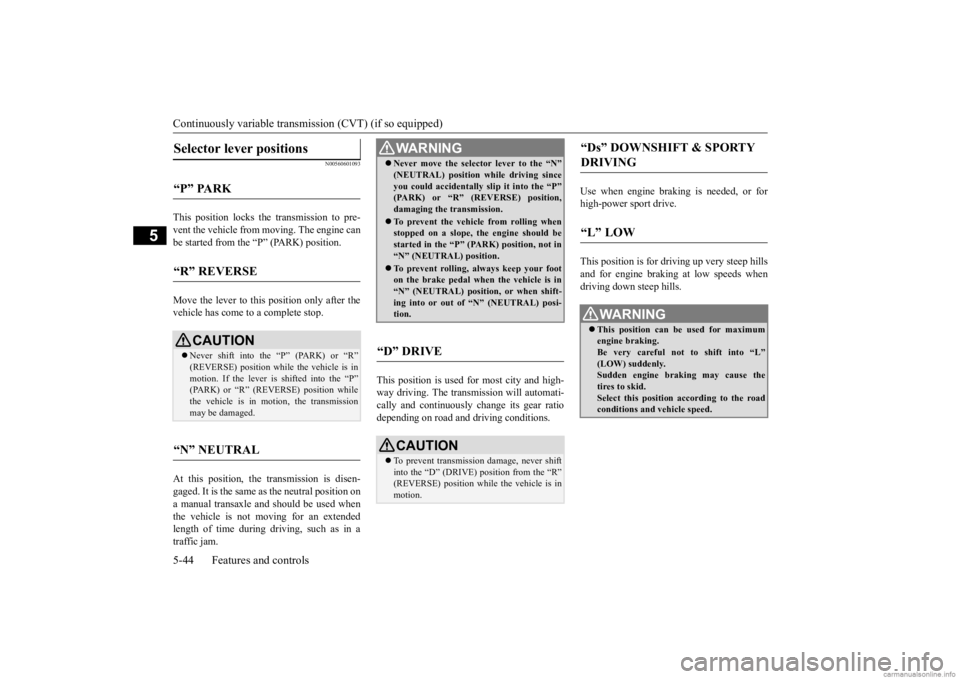
Continuously variable transmission (CVT) (if so equipped) 5-44 Features and controls
5
N00560601093
This position locks the transmission to pre- vent the vehicle from
moving. The engine can
be started from the “P” (PARK) position. Move the lever to this
position only after the
vehicle has come to a complete stop. At this position, the transmission is disen- gaged. It is the same
as the neutral position on
a manual transaxle and should be used when the vehicle is not m
oving for an extended
length of time during driving, such as in atraffic jam.
This position is used fo
r most city and high-
way driving. The transmission will automati- cally and continuously ch
ange its gear ratio
depending on road and driving conditions.
Use when engine braking is needed, or for high-power sport drive. This position is for driving up very steep hills and for engine braking at low speeds when driving down steep hills.
Selector lever positions
“P” PARK
“R” REVERSE
CAUTION Never shift into the “P” (PARK) or “R” (REVERSE) position while the vehicle is in motion. If the lever is shifted into the “P” (PARK) or “R” (REVERSE) position whilethe vehicle is in motion, the transmission may be damaged.
“N” NEUTRAL
WA R N I N G Never move the select
or lever to the “N”
(NEUTRAL) position while driving sinceyou could accidentally
slip it into the “P”
(PARK) or “R” (REVERSE) position, damaging the transmission. To prevent the vehicle from rolling when stopped on a slope,
the engine should be
started in the “P” (PARK) position, not in“N” (NEUTRAL) position. To prevent rolling,
always keep your foot
on the brake pedal when the vehicle is in “N” (NEUTRAL) positi
on, or when shift-
ing into or out of “N” (NEUTRAL) posi-tion.
“D” DRIVE
CAUTION To prevent transmission damage, never shift into the “D” (DRIVE) position from the “R” (REVERSE) position while the vehicle is in motion.
“Ds” DOWNSHIFT & SPORTY DRIVING
“L” LOW
WA R N I N G This position can be used for maximum engine braking. Be very careful not to shift into “L”(LOW) suddenly. Sudden engine brak
ing may cause the
tires to skid.Select this position according to the road conditions and vehicle speed.
BK0284300US.book 44 ページ 2019年5月23日 木曜日 午後12時22分
Page 111 of 253
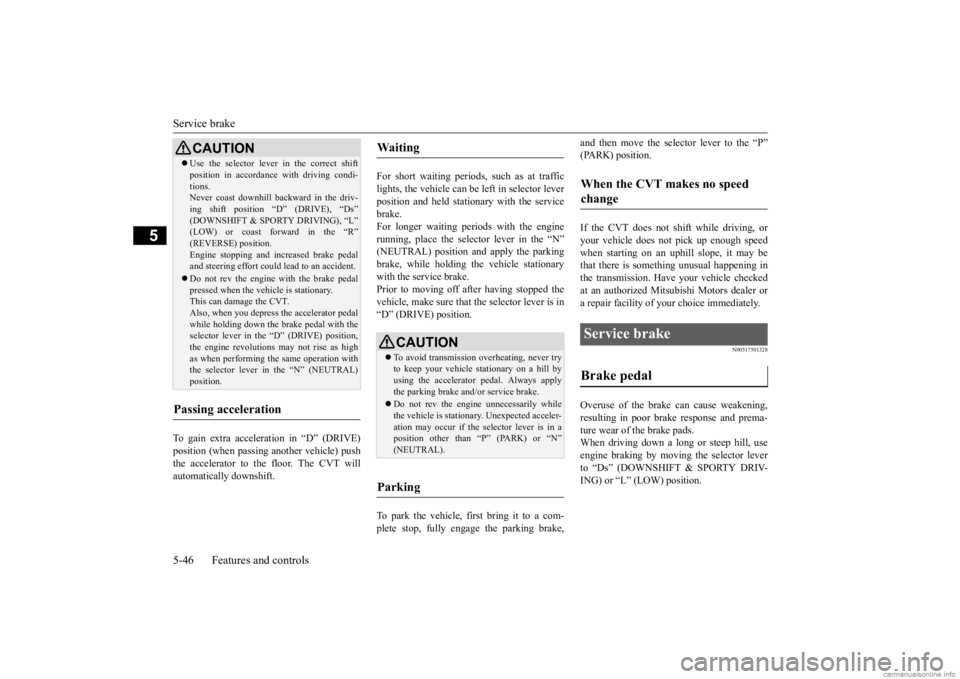
Service brake 5-46 Features and controls
5
To gain extra acceleration in “D” (DRIVE) position (when passing an
other vehicle) push
the accelerator to the floor. The CVT will automatically downshift.
For short waiting periods, such as at traffic lights, the vehicle can be
left in selector lever
position and held stationary with the servicebrake. For longer waiting periods with the engine running, place th
e selector lever in the “N”
(NEUTRAL) position and apply the parking brake, while holding the vehicle stationary with the service brake. Prior to moving off after having stopped the vehicle, make sure that the selector lever is in“D” (DRIVE) position. To park the vehicle, fi
rst bring it to a com-
plete stop, fully engage the parking brake,
and then move the selector lever to the “P” (PARK) position. If the CVT does not shift while driving, or your vehicle does not pick up enough speed when starting on an uphill slope, it may bethat there is something unusual happening in the transmission. Have your vehicle checked at an authorized Mitsubishi Motors dealer or a repair facility of your choice immediately.
N00517501328
Overuse of the brake can cause weakening,resulting in poor brake response and prema- ture wear of the brake pads.When driving down a long or steep hill, use engine braking by moving
the selector lever
to “Ds” (DOWNSHIFT & SPORTY DRIV-ING) or “L” (LOW) position.
Use the selector lever in the correct shift position in accordance
with driving condi-
tions.Never coast downhill backward in the driv- ing shift position “D” (DRIVE), “Ds” (DOWNSHIFT & SPORTY DRIVING), “L”(LOW) or coast forward in the “R” (REVERSE) position. Engine stopping and in
creased brake pedal
and steering effort could
lead to an accident.
Do not rev the engine
with the brake pedal
pressed when the vehi
cle is stationary.
This can damage the CVT. Also, when you depress
the accelera
tor pedal
while holding down the brake pedal with the selector lever in the “D” (DRIVE) position, the engine revolutions
may not rise as high
as when performing the same operation with the selector lever in the “N” (NEUTRAL) position.
Passing acceleration
CAUTION
Wa i t in g
CAUTION To avoid transmission overheating, never try to keep your vehicle stationary on a hill by using the accelerator
pedal. Always apply
the parking brake and/or service brake. Do not rev the engine unnecessarily while the vehicle is stationary. Unexpected acceler-ation may occur if the se
lector lever is in a
position other than “P” (PARK) or “N” (NEUTRAL).
Parking
When the CVT makes no speed change
Service brake Brake pedal
BK0284300US.book 46 ページ 2019年5月23日 木曜日 午後12時22分
Page 112 of 253
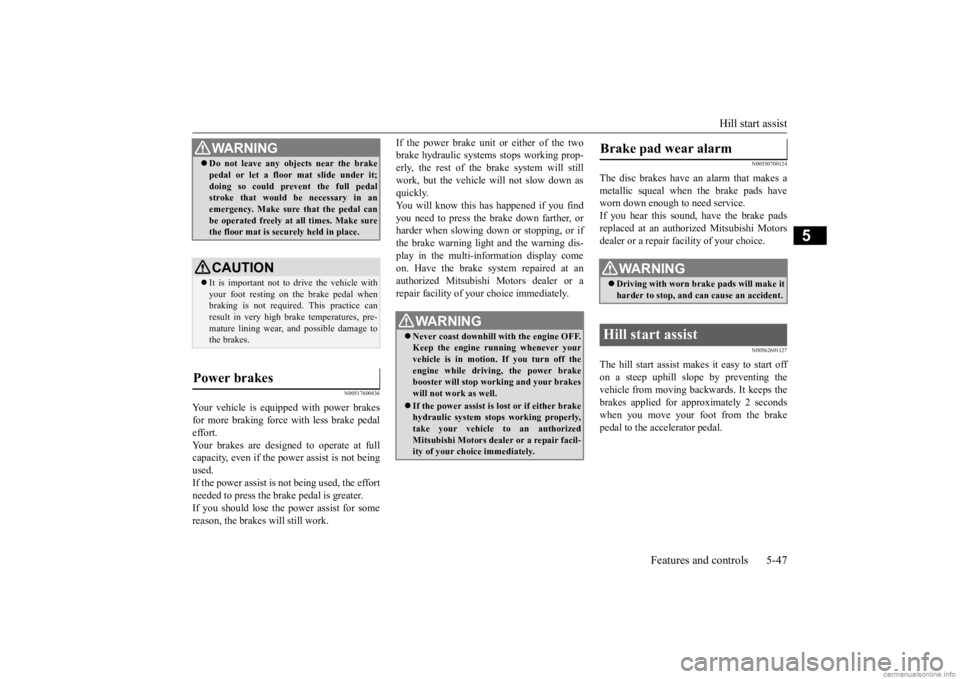
Hill start assist
Features and controls 5-47
5
N00517600436
Your vehicle is equipped with power brakes for more braking force with less brake pedaleffort. Your brakes are designed to operate at full capacity, even if the power assist is not beingused. If the power assist is not being used, the effort needed to press the brake pedal is greater.If you should lose the power assist for some reason, the brakes will still work.
If the power brake unit or either of the two brake hydraulic systems stops working prop-erly, the rest of the brake system will still work, but the vehicle
will not slow down as
quickly.You will know this has happened if you find you need to press the brake down farther, or harder when slowing down or stopping, or ifthe brake warning light and the warning dis- play in the multi-information display come on. Have the brake system repaired at an authorized Mitsubishi Motors dealer or a repair facility of your choice immediately.
N00550700124
The disc brakes have an alarm that makes a metallic squeal when
the brake pads have
worn down enough to need service.If you hear this sound, have the brake pads replaced at an authorized Mitsubishi Motors dealer or a repair fa
cility of your choice.
N00562601127
The hill start assist make
s it easy to start off
on a steep uphill slope by preventing the vehicle from moving back
wards. It keeps the
brakes applied for approximately 2 secondswhen you move your foot from the brake pedal to the accelerator pedal.
WA R N I N G Do not leave any objects near the brake pedal or let a floor mat slide under it;doing so could prevent the full pedalstroke that would be necessary in an emergency. Make sure that the pedal can be operated freely at all times. Make surethe floor mat is securely held in place.CAUTION It is important not to drive the vehicle with your foot resting on the brake pedal when braking is not required. This practice canresult in very high brake temperatures, pre- mature lining wear, a
nd possible damage to
the brakes.
Power brakes
WA R N I N G Never coast downhill
with the engine OFF.
Keep the engine running whenever your vehicle is in motion. If you turn off theengine while driving, the power brake booster will stop wo
rking and your brakes
will not work as well. If the power assist is lost or if either brake hydraulic system stops working properly,take your vehicle to an authorized Mitsubishi Motors dealer or a repair facil- ity of your choice immediately.
Brake pad wear alarm
WA R N I N G Driving with worn brake pads will make it harder to stop, and can cause an accident.
Hill start assist
BK0284300US.book 47 ページ 2019年5月23日 木曜日 午後12時22分
Page 113 of 253
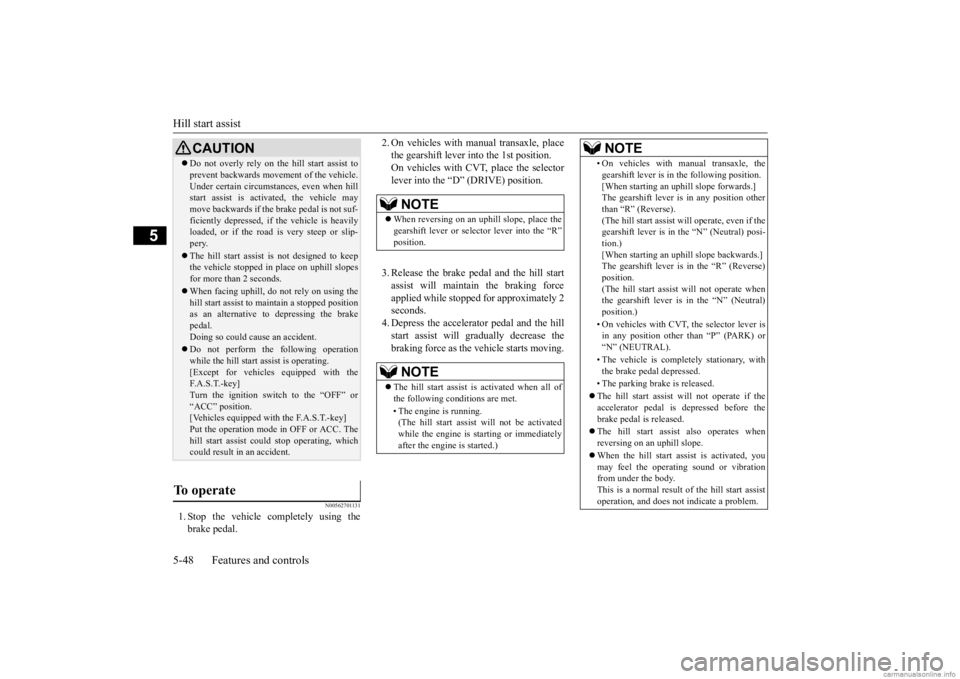
Hill start assist 5-48 Features and controls
5
N00562701131
1. Stop the vehicle completely using the brake pedal.
2. On vehicles with ma
nual transaxle, place
the gearshift lever into the 1st position.On vehicles with CVT, place the selector lever into the “D” (DRIVE) position. 3. Release the brake pedal and the hill start assist will maintain the braking force applied while stopped
for approximately 2
seconds. 4. Depress the accelera
tor pedal and the hill
start assist will gr
adually decrease the
braking force as the vehicle starts moving.
CAUTION Do not overly rely on th
e hill start assist to
prevent backwards movement of the vehicle.Under certain circumstances, even when hillstart assist is activated, the vehicle may move backwards if the brake pedal is not suf- ficiently depressed, if
the vehicle is heavily
loaded, or if the road is very steep or slip- pery. The hill start assist
is not designed to keep
the vehicle stopped in
place on uphill slopes
for more than 2 seconds. When facing uphill, do not rely on using the hill start assist to ma
intain a stopped position
as an alternative to depressing the brake pedal. Doing so could cause an accident. Do not perform the
following operation
while the hill start assist is operating.[Except for vehicles
equipped with the
F. A . S . T. - k e y ] Turn the ignition switch to the “OFF” or“ACC” position. [Vehicles equipped with the F.A.S.T.-key] Put the operation mode
in OFF or ACC. The
hill start assist coul
d stop operating, which
could result in an accident.
To operate
NOTE
When reversing on an uphill slope, place the gearshift lever or selector lever into the “R”position.NOTE
The hill start assist is activated when all of the following conditions are met. • The engine is running. (The hill start assist
will not be activated
while the engine is st
arting or immediately
after the engine is started.)
• On vehicles with manual transaxle, thegearshift lever is in the following position.[When starting an uphi
ll slope forwards.]
The gearshift lever is in any position other than “R” (Reverse). (The hill start assist will operate, even if thegearshift lever is in the “N” (Neutral) posi- tion.) [When starting an uphill
slope backwards.]
The gearshift lever is in the “R” (Reverse) position. (The hill start assist
will not operate when
the gearshift lever is in the “N” (Neutral) position.) • On vehicles with CVT,
the selector lever is
in any position other than “P” (PARK) or “N” (NEUTRAL). • The vehicle is comple
tely stationary, with
the brake pedal depressed. • The parking brake is released. The hill start assist wi
ll not operate if the
accelerator pedal is
depressed before the
brake pedal is released. The hill start assist also operates when reversing on an uphill slope. When the hill start a
ssist is ac
tivated, you
may feel the operating sound or vibrationfrom under the body. This is a normal result of the hill start assist operation, and does not indicate a problem.NOTE
BK0284300US.book 48 ページ 2019年5月23日 木曜日 午後12時22分